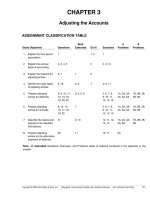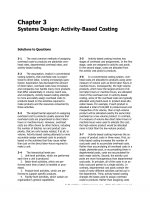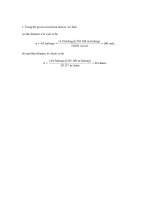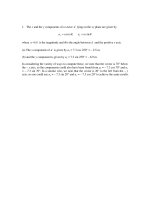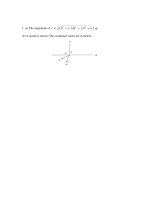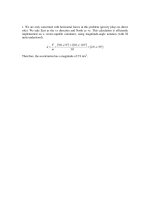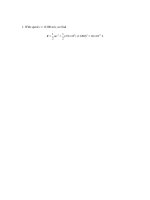Solution manual vector mechanics engineers dynamics 8th beer chapter 03
Bạn đang xem bản rút gọn của tài liệu. Xem và tải ngay bản đầy đủ của tài liệu tại đây (4.42 MB, 180 trang )
COSMOS: Complete Online Solutions Manual Organization System
Chapter 3, Solution 1.
Resolve 90 N force into vector components P and Q
where Q = ( 90 N ) sin 40°
= 57.851 N
Then M B = − rA/BQ
= − (0.225 m )(57.851 N )
= −13.0165 N ⋅ m
M B = 13.02 N ⋅ m
Vector Mechanics for Engineers: Statics and Dynamics, 8/e, Ferdinand P. Beer, E. Russell Johnston, Jr.,
Elliot R. Eisenberg, William E. Clausen, David Mazurek, Phillip J. Cornwell
© 2007 The McGraw-Hill Companies.
COSMOS: Complete Online Solutions Manual Organization System
Chapter 3, Solution 2.
Fx = ( 90 N ) cos 25°
= 81.568 N
Fy = ( 90 N ) sin 25°
= 38.036 N
x = ( 0.225 m ) cos 65°
= 0.095089 m
y = (0.225 m ) sin 65°
= 0.20392 m
M B = xFy − yFx
= ( 0.095089 m )( 38.036 N ) − ( 0.20392 m )( 81.568 N )
= −13.0165 N ⋅ m
M B = 13.02 N ⋅ m
Vector Mechanics for Engineers: Statics and Dynamics, 8/e, Ferdinand P. Beer, E. Russell Johnston, Jr.,
Elliot R. Eisenberg, William E. Clausen, David Mazurek, Phillip J. Cornwell
© 2007 The McGraw-Hill Companies.
COSMOS: Complete Online Solutions Manual Organization System
Chapter 3, Solution 3.
Px = ( 3 lb ) sin 30°
= 1.5 lb
Py = ( 3 lb ) cos 30°
= 2.5981 lb
M A = xB/ A Py + yB/ A Px
= ( 3.4 in.)( 2.5981 lb ) + ( 4.8 in.)(1.5 lb )
= 16.0335 lb ⋅ in.
M A = 16.03 lb ⋅ in.
Vector Mechanics for Engineers: Statics and Dynamics, 8/e, Ferdinand P. Beer, E. Russell Johnston, Jr.,
Elliot R. Eisenberg, William E. Clausen, David Mazurek, Phillip J. Cornwell
© 2007 The McGraw-Hill Companies.
COSMOS: Complete Online Solutions Manual Organization System
Chapter 3, Solution 4.
For P to be a minimum, it must be perpendicular to the line joining points
A and B
with rAB =
( 3.4 in.)2 + ( 4.8 in.)2
= 5.8822 in.
y
α = θ = tan −1
x
4.8 in.
= tan −1
3.4 in.
= 54.689°
Then
M A = rAB Pmin
or
Pmin =
M A 19.5 lb ⋅ in.
=
rAB
5.8822 in.
= 3.3151 lb
∴ Pmin = 3.32 lb
54.7°
or
Vector Mechanics for Engineers: Statics and Dynamics, 8/e, Ferdinand P. Beer, E. Russell Johnston, Jr.,
Elliot R. Eisenberg, William E. Clausen, David Mazurek, Phillip J. Cornwell
© 2007 The McGraw-Hill Companies.
Pmin = 3.32 lb
35.3°
COSMOS: Complete Online Solutions Manual Organization System
Chapter 3, Solution 5.
M A = rB/ A P sin θ
By definition
where
θ = φ + ( 90° − α )
and
φ = tan −1
4.8 in.
3.4 in.
= 54.689°
Also
rB/ A =
( 3.4 in.)2 + ( 4.8 in.)2
= 5.8822 in.
Then
(17 lb ⋅ in.) = ( 5.8822 in.)( 2.9 lb ) sin ( 54.689° + 90° − α )
or
sin (144.689° − α ) = 0.99658
or
144.689° − α = 85.260°; 94.740°
∴ α = 49.9°, 59.4°
Vector Mechanics for Engineers: Statics and Dynamics, 8/e, Ferdinand P. Beer, E. Russell Johnston, Jr.,
Elliot R. Eisenberg, William E. Clausen, David Mazurek, Phillip J. Cornwell
© 2007 The McGraw-Hill Companies.
COSMOS: Complete Online Solutions Manual Organization System
Chapter 3, Solution 6.
(a)
(a) M A = rB/ A × TBF
M A = xTBFy + yTBFx
= ( 2 m )( 200 N ) sin 60° + ( 0.4 m )( 200 N ) cos 60°
= 386.41 N ⋅ m
or M A = 386 N ⋅ m
(b)
(b) For FC to be a minimum, it must be perpendicular to the line
joining A and C.
∴ M A = d ( FC )min
d =
with
( 2 m )2 + (1.35 m )2
= 2.4130 m
Then 386.41 N ⋅ m = ( 2.4130 m ) ( FC )min
( FC )min
and
= 160.137 N
1.35 m
= 34.019°
2m
φ = tan −1
θ = 90 − φ = 90° − 34.019° = 55.981°
∴ ( FC )min = 160.1 N
Vector Mechanics for Engineers: Statics and Dynamics, 8/e, Ferdinand P. Beer, E. Russell Johnston, Jr.,
Elliot R. Eisenberg, William E. Clausen, David Mazurek, Phillip J. Cornwell
© 2007 The McGraw-Hill Companies.
56.0°
COSMOS: Complete Online Solutions Manual Organization System
Chapter 3, Solution 7.
(a)
M A = xTBFy + yTBFx
= ( 2 m )( 200 N ) sin 60° + ( 0.4 m )( 200 N ) cos 60°
= 386.41 N ⋅ m
or M A = 386 N ⋅ m
(b)
Have
or
M A = xFC
FC =
MA
386.41 N ⋅ m
=
2m
x
= 193.205 N
(c)
∴ FC = 193.2 N
For FB to be minimum, it must be perpendicular to the line joining A
and B
∴ M A = d ( FB )min
with
Then
d =
= 2.0396 m
386.41 N ⋅ m = ( 2.0396 m ) ( FC )min
( FC )min
and
( 2 m )2 + ( 0.40 m )2
= 189.454 N
2m
= 78.690°
0.4 m
θ = tan −1
or
Vector Mechanics for Engineers: Statics and Dynamics, 8/e, Ferdinand P. Beer, E. Russell Johnston, Jr.,
Elliot R. Eisenberg, William E. Clausen, David Mazurek, Phillip J. Cornwell
© 2007 The McGraw-Hill Companies.
( FC )min
= 189.5 N
78.7°
COSMOS: Complete Online Solutions Manual Organization System
Chapter 3, Solution 8.
(a)
(
)
M B = rA/B cos15° W
= (14 in.)( cos15° )( 5 lb )
= 67.615 lb ⋅ in.
or
M B = 67.6 lb ⋅ in.
(b)
M B = rD/B P sin 85°
67.615 lb ⋅ in. = ( 3.2 in.) P sin 85°
or
(c)
P = 21.2 lb
For ( F )min, F must be perpendicular to BC.
Then,
M B = rC/B F
67.615 lb ⋅ in. = (18 in.) F
or
Vector Mechanics for Engineers: Statics and Dynamics, 8/e, Ferdinand P. Beer, E. Russell Johnston, Jr.,
Elliot R. Eisenberg, William E. Clausen, David Mazurek, Phillip J. Cornwell
© 2007 The McGraw-Hill Companies.
F = 3.76 lb
75.0°
COSMOS: Complete Online Solutions Manual Organization System
Chapter 3, Solution 9.
Slope of line EC =
(a)
Then
and
Then
TABx =
35 in.
5
=
76 in. + 8 in. 12
12
(TAB )
13
=
12
( 260 lb ) = 240 lb
13
TABy =
5
( 260 lb ) = 100 lb
13
M D = TABx ( 35 in.) − TABy ( 8 in.)
= ( 240 lb )( 35 in.) − (100 lb )( 8 in.)
= 7600 lb ⋅ in.
or M D = 7600 lb ⋅ in.
(b) Have
M D = TABx ( y ) + TABy ( x )
= ( 240 lb )( 0 ) + (100 lb )( 76 in.)
= 7600 lb ⋅ in.
or M D = 7600 lb ⋅ in.
Vector Mechanics for Engineers: Statics and Dynamics, 8/e, Ferdinand P. Beer, E. Russell Johnston, Jr.,
Elliot R. Eisenberg, William E. Clausen, David Mazurek, Phillip J. Cornwell
© 2007 The McGraw-Hill Companies.
COSMOS: Complete Online Solutions Manual Organization System
Chapter 3, Solution 10.
Slope of line EC =
35 in.
7
=
112 in. + 8 in. 24
Then
TABx =
24
TAB
25
and
TABy =
7
TAB
25
M D = TABx ( y ) + TABy ( x )
Have
∴ 7840 lb ⋅ in. =
24
7
TAB ( 0 ) +
TAB (112 in.)
25
25
TAB = 250 lb
or TAB = 250 lb
Vector Mechanics for Engineers: Statics and Dynamics, 8/e, Ferdinand P. Beer, E. Russell Johnston, Jr.,
Elliot R. Eisenberg, William E. Clausen, David Mazurek, Phillip J. Cornwell
© 2007 The McGraw-Hill Companies.
COSMOS: Complete Online Solutions Manual Organization System
Chapter 3, Solution 11.
The minimum value of d can be found based on the equation relating the moment of the force TAB about D:
M D = (TAB max ) y ( d )
M D = 1152 N ⋅ m
where
(TAB max ) y
Now
sin θ =
= TAB max sin θ = ( 2880 N ) sin θ
1.05 m
(d
∴ 1152 N ⋅ m = 2880 N
+ 0.24 ) + (1.05 ) m
2
2
1.05
(d
+ 0.24 ) + (1.05 )
2
( d + 0.24 )2 + (1.05)2
or
or
2
(d )
(d
or
= 2.625d
+ 0.24 ) + (1.05 ) = 6.8906d 2
2
2
5.8906d 2 − 0.48d − 1.1601 = 0
Using the quadratic equation, the minimum values of d are 0.48639 m and −0.40490 m.
Since only the positive value applies here, d = 0.48639 m
or d = 486 mm
Vector Mechanics for Engineers: Statics and Dynamics, 8/e, Ferdinand P. Beer, E. Russell Johnston, Jr.,
Elliot R. Eisenberg, William E. Clausen, David Mazurek, Phillip J. Cornwell
© 2007 The McGraw-Hill Companies.
COSMOS: Complete Online Solutions Manual Organization System
Chapter 3, Solution 12.
with d AB =
( 42 mm )2 + (144 mm )2
= 150 mm
sin θ =
42 mm
150 mm
cosθ =
144 mm
150 mm
and FAB = − FAB sin θ i − FAB cosθ j
=
2.5 kN
( − 42 mm ) i − (144 mm ) j
150 mm
= − ( 700 N ) i − ( 2400 N ) j
Also rB/C = − ( 0.042 m ) i + ( 0.056 m ) j
Now M C = rB/C × FAB
= ( − 0.042 i + 0.056 j) × ( − 700 i − 2400 j) N ⋅ m
= (140.0 N ⋅ m ) k
or
Vector Mechanics for Engineers: Statics and Dynamics, 8/e, Ferdinand P. Beer, E. Russell Johnston, Jr.,
Elliot R. Eisenberg, William E. Clausen, David Mazurek, Phillip J. Cornwell
© 2007 The McGraw-Hill Companies.
M C = 140.0 N ⋅ m
COSMOS: Complete Online Solutions Manual Organization System
Chapter 3, Solution 13.
( 42 mm )2 + (144 mm )2
with d AB =
= 150 mm
sin θ =
42 mm
150 mm
cosθ =
144 mm
150 mm
FAB = − FAB sin θ i − FAB cosθ j
=
2.5 kN
( − 42 mm ) i − (144 mm ) j
150 mm
= − ( 700 N ) i − ( 2400 N ) j
Also rB/C = − ( 0.042 m ) i − ( 0.056 m ) j
Now M C = rB/C × FAB
= ( − 0.042 i − 0.056 j) × ( − 700i − 2400 j) N ⋅ m
= ( 61.6 N ⋅ m ) k
or
Vector Mechanics for Engineers: Statics and Dynamics, 8/e, Ferdinand P. Beer, E. Russell Johnston, Jr.,
Elliot R. Eisenberg, William E. Clausen, David Mazurek, Phillip J. Cornwell
© 2007 The McGraw-Hill Companies.
M C = 61.6 N ⋅ m
COSMOS: Complete Online Solutions Manual Organization System
Chapter 3, Solution 14.
ΣM D :
88
105
M D = ( 0.090 m )
× 80 N − ( 0.280 m )
× 80 N
137
137
= −12.5431 N ⋅ m
or
Vector Mechanics for Engineers: Statics and Dynamics, 8/e, Ferdinand P. Beer, E. Russell Johnston, Jr.,
Elliot R. Eisenberg, William E. Clausen, David Mazurek, Phillip J. Cornwell
© 2007 The McGraw-Hill Companies.
M D = 12.54 N ⋅ m
COSMOS: Complete Online Solutions Manual Organization System
Chapter 3, Solution 15.
Note: B = B ( cos β i + sin β j)
B′ = B ( cos β i − sin β j)
C = C ( cos α i + sin α j)
By definition:
B × C = BC sin (α − β )
(1)
B′ × C = BC sin (α + β )
(2)
Now ... B × C = B ( cos β i + sin β j) × C ( cos α i + sin α j)
= BC ( cos β sin α − sin β cos α ) k
and
(3)
B′ × C = B ( cos β i − sin β j) × C ( cos α i + sin α j)
= BC ( cos β sin α + sin β cos α ) k
(4)
Equating the magnitudes of B × C from equations (1) and (3) yields:
BC sin (α − β ) = BC ( cos β sin α − sin β cos α )
(5)
Similarly, equating the magnitudes of B′ × C from equations (2) and (4) yields:
BC sin (α + β ) = BC ( cos β sin α + sin β cos α )
(6)
Adding equations (5) and (6) gives:
sin (α − β ) + sin (α + β ) = 2cos β sin α
or
sin α cos β =
Vector Mechanics for Engineers: Statics and Dynamics, 8/e, Ferdinand P. Beer, E. Russell Johnston, Jr.,
Elliot R. Eisenberg, William E. Clausen, David Mazurek, Phillip J. Cornwell
© 2007 The McGraw-Hill Companies.
1
1
sin (α + β ) + sin (α − β )
2
2
COSMOS: Complete Online Solutions Manual Organization System
Chapter 3, Solution 16.
Have d = λ AB × rO/ A
where λ AB =
rB/ A
rB/ A
and rB/ A = ( −210 mm − 630 mm ) i
+ ( 270 mm − ( −225 mm ) ) j
= − ( 840 mm ) i + ( 495 mm ) j
rB/ A =
( −840 mm )2 + ( 495 mm )2
= 975 mm
Then λ AB =
=
− ( 840 mm ) i + ( 495 mm ) j
975 mm
1
( −56i + 33j)
65
Also rO/ A = ( 0 − 630 ) i + ( 0 − (−225) ) j
= − ( 630 mm ) i + ( 225 mm ) j
∴d =
1
( −56i + 33j) × − ( 630 mm ) i + ( 225 mm ) j
65
= 126.0 mm
d = 126.0 mm W
Vector Mechanics for Engineers: Statics and Dynamics, 8/e, Ferdinand P. Beer, E. Russell Johnston, Jr.,
Elliot R. Eisenberg, William E. Clausen, David Mazurek, Phillip J. Cornwell
© 2007 The McGraw-Hill Companies.
COSMOS: Complete Online Solutions Manual Organization System
Chapter 3, Solution 17.
(a)
where
λ =
A×B
A×B
A = 12i − 6 j + 9k
B = − 3i + 9 j − 7.5k
Then
i
j
k
A × B = 12 − 6 9
− 3 9 − 7.5
= ( 45 − 81) i + ( −27 + 90 ) j + (108 − 18 ) k
= 9 ( − 4i + 7 j + 10k )
And A × B = 9 (− 4) 2 + (7)2 + (10)2 = 9 165
∴λ =
9 ( − 4i + 7 j + 10k )
9 165
or λ =
(b)
where
λ =
A×B
A×B
A = −14i − 2 j + 8k
B = 3i + 1.5j − k
Then
j k
i
A × B = −14 − 2 8
3 1.5 −1
= ( 2 − 12 ) i + ( 24 − 14 ) j + ( −21 + 6 ) k
= 5 ( −2i + 2 j − 3k )
and
A × B = 5 (−2)2 + (2)2 + (−3)2 = 5 17
∴λ =
or λ =
5 ( −2i + 2 j − 3k )
5 17
1
( − 2i + 2 j − 3k )
17
Vector Mechanics for Engineers: Statics and Dynamics, 8/e, Ferdinand P. Beer, E. Russell Johnston, Jr.,
Elliot R. Eisenberg, William E. Clausen, David Mazurek, Phillip J. Cornwell
© 2007 The McGraw-Hill Companies.
1
( − 4i + 7 j + 10k )
165
COSMOS: Complete Online Solutions Manual Organization System
Chapter 3, Solution 18.
(a)
Have A = P × Q
i j k
P × Q = 3 7 −2 in.2
−5 1 3
= [ (21 + 2)i + (10 − 9) j + (3 + 35)k ] in.2
(
) (
) (
)
= 23 in.2 i + 1 in.2 j + 38 in.2 k
∴A=
(23)2 + (1)2 + (38) 2 = 44.430 in.2
or A = 44.4 in.2 W
(b)
A = P×Q
i j k
P × Q = 2 − 4 3 in.2
6 −1 5
= [ (−20 − 3)i + (−18 − 10) j + (−2 + 24)k ] in.2
(
) (
) (
)
= − 23 in.2 i − 28 in.2 j + 22 in.2 k
∴A=
(− 23)2 + (−28)2 + (22) 2 = 42.391 in.2
or A = 42.4 in.2 W
Vector Mechanics for Engineers: Statics and Dynamics, 8/e, Ferdinand P. Beer, E. Russell Johnston, Jr.,
Elliot R. Eisenberg, William E. Clausen, David Mazurek, Phillip J. Cornwell
© 2007 The McGraw-Hill Companies.
COSMOS: Complete Online Solutions Manual Organization System
Chapter 3, Solution 19.
(a)
Have
MO = r × F
i
j
k
= − 6 3 1.5 N ⋅ m
7.5 3 − 4.5
= [ (−13.5 − 4.5)i + (11.25 − 27) j + (−18 − 22.5)k ] N ⋅ m
= ( −18.00i − 15.75 j − 40.5k ) N ⋅ m
or M O = − (18.00 N ⋅ m ) i − (15.75 Ν ⋅ m ) j − ( 40.5 N ⋅ m ) k W
(b)
Have
MO = r × F
i
j
k
= 2 − 0.75 −1 N ⋅ m
7.5
3
− 4.5
= [ (3.375 + 3)i + (−7.5 + 9) j + (6 + 5.625)k ] N ⋅ m
= ( 6.375i + 1.500 j + 11.625k ) N ⋅ m
or M O = ( 6.38 N ⋅ m ) i + (1.500 Ν ⋅ m ) j + (11.63 Ν ⋅ m ) k W
(c)
Have
MO = r × F
i
j k
= − 2.5 −1 1.5 N ⋅ m
7.5 3 4.5
= [ (4.5 − 4.5)i + (11.25 − 11.25) j + (−7.5 + 7.5)k ] N ⋅ m
or M O = 0 W
This answer is expected since r and F are proportional ( F = −3r ) . Therefore, vector F has a line of action
passing through the origin at O.
Vector Mechanics for Engineers: Statics and Dynamics, 8/e, Ferdinand P. Beer, E. Russell Johnston, Jr.,
Elliot R. Eisenberg, William E. Clausen, David Mazurek, Phillip J. Cornwell
© 2007 The McGraw-Hill Companies.
COSMOS: Complete Online Solutions Manual Organization System
Chapter 3, Solution 20.
(a)
Have
MO = r × F
i
j k
= − 7.5 3 − 6 lb ⋅ ft
3 −6 4
= [ (12 − 36)i + (−18 + 30) j + (45 − 9)k ] lb ⋅ ft
or M O = − ( 24.0 lb ⋅ ft ) i + (12.00 lb ⋅ ft ) j + ( 36.0 lb ⋅ ft ) k W
(b)
Have
MO = r × F
i
j k
= − 7.5 1.5 −1 lb ⋅ ft
3 −6 4
= [ (6 − 6)i + (−3 + 3) j + (4.5 − 4.5)k ] lb ⋅ ft
or M O = 0 W
(c)
Have
MO = r × F
i
j
k
= − 8 2 −14 lb ⋅ ft
3 −6 4
= [ (8 − 84)i + (−42 + 32) j + (48 − 6)k ] lb ⋅ ft
or M O = − ( 76.0 lb ⋅ ft ) i − (10.00 lb ⋅ ft ) j + ( 42.0 lb ⋅ ft ) k W
Vector Mechanics for Engineers: Statics and Dynamics, 8/e, Ferdinand P. Beer, E. Russell Johnston, Jr.,
Elliot R. Eisenberg, William E. Clausen, David Mazurek, Phillip J. Cornwell
© 2007 The McGraw-Hill Companies.
COSMOS: Complete Online Solutions Manual Organization System
Chapter 3, Solution 21.
With
TAB = − ( 369 N ) j
TAB = TAD
JJJG
AD
= ( 369 N )
AD
( 2.4 m ) i − ( 3.1 m ) j − (1.2 m ) k
( 2.4 m )2 + ( −3.1 m )2 + ( −1.2 m )2
TAD = ( 216 N ) i − ( 279 N ) j − (108 N ) k
Then
R A = 2 TAB + TAD
= ( 216 N ) i − (1017 N ) j − (108 N ) k
Also
rA/C = ( 3.1 m ) i + (1.2 m ) k
Have
M C = rA/C × R A
i
j
k
= 0
3.1
1.2 N ⋅ m
216 −1017 −108
= ( 885.6 N ⋅ m ) i + ( 259.2 N ⋅ m ) j − ( 669.6 N ⋅ m ) k
M C = ( 886 N ⋅ m ) i + ( 259 N ⋅ m ) j − ( 670 N ⋅ m ) k W
Vector Mechanics for Engineers: Statics and Dynamics, 8/e, Ferdinand P. Beer, E. Russell Johnston, Jr.,
Elliot R. Eisenberg, William E. Clausen, David Mazurek, Phillip J. Cornwell
© 2007 The McGraw-Hill Companies.
COSMOS: Complete Online Solutions Manual Organization System
Chapter 3, Solution 22.
Have
M A = rC/ A × F
where
rC/ A = ( 215 mm ) i − ( 50 mm ) j + (140 mm ) k
Fx = − ( 36 N ) cos 45° sin12°
Fy = − ( 36 N ) sin 45°
Fz = − ( 36 N ) cos 45° cos12°
∴ F = − ( 5.2926 N ) i − ( 25.456 N ) j − ( 24.900 N ) k
and
i
j
k
M A = 0.215
− 0.050
0.140 N ⋅ m
− 5.2926 − 25.456 − 24.900
= ( 4.8088 N ⋅ m ) i + ( 4.6125 N ⋅ m ) j − ( 5.7377 N ⋅ m ) k
M A = ( 4.81 N ⋅ m ) i + ( 4.61 N ⋅ m ) j − ( 5.74 N ⋅ m ) k W
Vector Mechanics for Engineers: Statics and Dynamics, 8/e, Ferdinand P. Beer, E. Russell Johnston, Jr.,
Elliot R. Eisenberg, William E. Clausen, David Mazurek, Phillip J. Cornwell
© 2007 The McGraw-Hill Companies.
COSMOS: Complete Online Solutions Manual Organization System
Chapter 3, Solution 23.
Have
M O = rA/O × R
where
rA/D = ( 30 ft ) j + ( 3 ft ) k
T1 = − ( 62 lb ) cos10° i − ( 62 lb ) sin10° j
= − ( 61.058 lb ) i − (10.766 lb ) j
JJJG
AB
T2 = T2
AB
= ( 62 lb )
( 5 ft ) i − ( 30 ft ) j + ( 6 ft ) k
( 5 ft )2 + ( − 30 ft )2 + ( 6 ft )2
= (10 lb ) i − ( 60 lb ) j + (12 lb ) k
∴ R = − ( 51.058 lb ) i − ( 70.766 lb ) j + (12 lb ) k
MO
i
j
k
=
0
30
3 lb ⋅ ft
− 51.058 −70.766 12
= ( 572.30 lb ⋅ ft ) i − (153.17 lb ⋅ ft ) j + (1531.74 lb ⋅ ft ) k
M O = ( 572 lb ⋅ ft ) i − (153.2 lb ⋅ ft ) j + (1532 lb ⋅ ft ) k W
Vector Mechanics for Engineers: Statics and Dynamics, 8/e, Ferdinand P. Beer, E. Russell Johnston, Jr.,
Elliot R. Eisenberg, William E. Clausen, David Mazurek, Phillip J. Cornwell
© 2007 The McGraw-Hill Companies.
COSMOS: Complete Online Solutions Manual Organization System
Chapter 3, Solution 24.
(a)
Have
M O = rB/O × TBD
where
rB/O = ( 2.5 m ) i + ( 2 m ) j
TBD = TBD
JJJG
BD
BD
− (1 m ) i − ( 2 m ) j + ( 2 m ) k
= ( 900 N )
( −1 m ) 2 + ( − 2 m ) 2 + ( 2 m ) 2
= − ( 300 N ) i − ( 600 N ) j + ( 600 N ) k
Then
MO
i
j
k
= 2.5
2
0 N⋅m
− 300 − 600 600
M O = (1200 N ⋅ m ) i − (1500 N ⋅ m ) j − ( 900 N ⋅ m ) k W
continued
Vector Mechanics for Engineers: Statics and Dynamics, 8/e, Ferdinand P. Beer, E. Russell Johnston, Jr.,
Elliot R. Eisenberg, William E. Clausen, David Mazurek, Phillip J. Cornwell
© 2007 The McGraw-Hill Companies.
COSMOS: Complete Online Solutions Manual Organization System
(b)
Have
M O = rB/O × TBE
where
rB/O = ( 2.5 m ) i + ( 2 m ) j
TBE = TBE
JJJG
BE
BE
− ( 0.5 m ) i − ( 2 m ) j − ( 4 m ) k
= ( 675 N )
( 0.5 m )2 + ( −2 m )2 + ( − 4 m )2
= − ( 75 N ) i − ( 300 N ) j − ( 600 N ) k
Then
MO
i
j
k
= 2.5
2
0 N⋅m
− 75 − 300 − 600
M O = − (1200 N ⋅ m ) i + (1500 N ⋅ m ) j − ( 600 N ⋅ m ) k W
Vector Mechanics for Engineers: Statics and Dynamics, 8/e, Ferdinand P. Beer, E. Russell Johnston, Jr.,
Elliot R. Eisenberg, William E. Clausen, David Mazurek, Phillip J. Cornwell
© 2007 The McGraw-Hill Companies.
